Related Research Articles

A transboundary protected area (TBPA) is an ecological protected area that spans boundaries of more than one country or sub-national entity. Such areas are also known as transfrontier conservation areas (TFCAs) or peace parks.
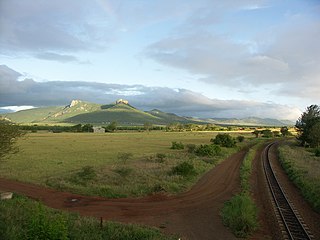
The Lebombo Mountains, also called Lubombo Mountains, are an 800 km-long (500 mi), narrow range of mountains in Southern Africa. They stretch from Hluhluwe in KwaZulu-Natal in the south to Punda Maria in the Limpopo Province in South Africa in the north. Parts of the mountain range are also found in Mozambique and Eswatini.
The Lubombo Transfrontier Conservation Area was born out of the Peace Park Foundation’s vision to establish a network of transfrontier conservation areas in southern Africa. It straddles the border between South Africa’s KwaZulu-Natal province, southern Mozambique, and Eswatini.
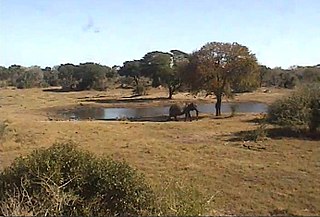
Tembe Elephant Park is a 30 012 ha game reserve in Maputaland, KwaZulu-Natal, South Africa. It is adjacent to Ndumo Game Reserve.
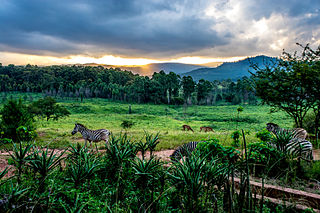
Mlilwane Wildlife Sanctuary is Eswatini's oldest protected area, owned and managed by a non-profit trust.

Malolotja National Park covers 18,000 hectares of mountain wilderness on Eswatini's northwestern border with South Africa. The park includes Ngwenya Mountain, Eswatini's second highest mountain, and Malolotja Falls which drop 89 metres (292 ft), the highest in Eswatini. Habitats include short grassland to thick riverine scrub, bushveld and Afromontane forest.
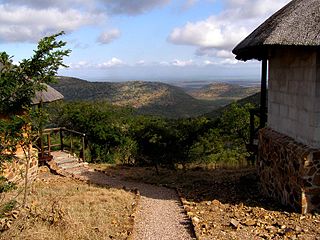
The Mlawula Nature Reserve is a nature reserve situated in north-eastern Eswatini. It covers approximately 16,500 hectares and is adjacent to Mbuluzi Game Reserve, Simunye Nature Reserve, and Hlane Royal National Park.
Songimvelo Game Reserve is a provincial park managed by the Mpumalanga Parks Board in Mpumalanga, South Africa. Songimvelo is a plural word that means 'we are conserving nature' in the siSwati language.
Lubombo Conservancy comprises 5 reserves in Eswatini:
Nsubane Pongola Transfrontier Conservation Area is a proposed protected area concept, that could potentially become a joint venture between South Africa and Eswatini. The concept includes the following properties:
The Songimvelo-Malolotja Transfrontier Censervation Area is a peace park located on the South Africa - Eswatini border between Barberton and Pigg's Peak (Eswatini) and covers an area of approximately 700 square kilometres (270 sq mi), with potential extensions of another 500 square kilometres (190 sq mi).
Usuthu-Tembe-Futi Transfrontier Conservation Area is a group of protected areas in southern Africa, straddling parts of South Africa, Mozambique and Eswatini, including the following:
Lubombo Conservancy-Goba Transfrontier Conservation Area is a joint project between Mozambique and Swaziland, based on the Peace Park agreements. The park will include the following area:
Maputo Special Reserve is a nature reserve in Mozambique.

Futi Corridor in Mozambique, is a corridor of land along the Futi River to the South African border. The corridor will effectively restore an historical migration and movement route of a valuable elephant population between Maputo Special Reserve and the Tembe Elephant Park in South Africa. The Futi Corridor covers 68.800 Ha. The Futi River is the northern extension of the drainage line known as the Mosi Swamp, which rises near Manaba about 55 km south of the border. The Futi River does not reach the sea, but ends in swamp grasslands in the north of the Maputo Reserve.
Mbuluzi Game Reserve is a privately owned reserve in Eswatini, within the Lubombo Conservancy. There are 3 lodges privately situated on the Mlawula River, and a campsite, situated above some rapids in the Mbuluzi River.
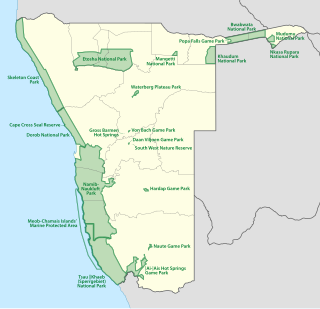
The protected areas of Namibia include its national parks and reserves. With the 2010 declaration of Dorob National Park, Namibia became the first and only country to have its entire coastline protected through a national parks network. Protected areas are subdivided into game reserves and/or nature reserves, such as special protected area, wilderness areas, natural areas, and development areas. There are also recreation reserves. Facilities in the national parks are operated by Namibia Wildlife Resorts. Over 19% of Namibia is protected, an area of some 130,000 square kilometres. However, the Ministry of Environment & Tourism auctions limited hunting rights within its protected areas. The Namibia Nature Foundation, an NGO, was established in 1987 to raise and administer funds for the conservation of wildlife and protected area management. Communal Wildlife Conservancies in Namibia help promote sustainable natural resource management by giving local communities rights to wildlife management and tourism.
The Peace Park Foundation, founded in 1997 by Dr Anton Rupert, President Nelson Mandela and Prince Bernhard of the Netherlands, is an organisation that aims to re-establish, renew and conserve large ecosystems in Africa, transcending man-made boundaries by creating regionally integrated and sustainably managed networks of Transfrontier Conservation Areas (TFCAs). Peace Parks Foundation has been involved in the establishment and development of ten of the 18 TFCAs found throughout southern Africa, all of which are in various stages of development. The establishment of each TFCA, or peace park, is complex and far-reaching, and involves several phases of activity, which can take many years to achieve.
References
- ↑ Mbuluzi Game Reserve Archived 2009-10-12 at the Wayback Machine
- ↑ "Dombeya Game Reserve". www.dombeya.org. Retrieved 12 September 2023.
- ↑ Mkhaya Game Reserve
- ↑ Nature Reserve [ permanent dead link ]
- ↑ Malolotja Nature Reserve
- ↑ Mantenga Nature Reserve
- ↑ Nature Reserve [ permanent dead link ]
- ↑ Shewula Community Nature Reserve
- ↑ "Welcome to the Lubombo Conservancy website". Lubombo Conservancy. Archived from the original on 16 July 2009. Retrieved 9 October 2009.
